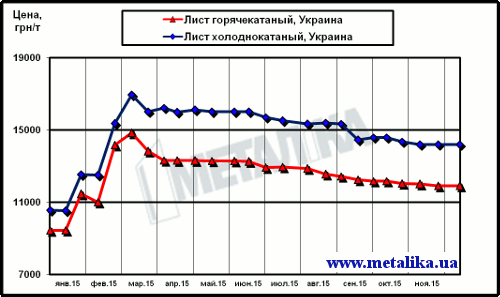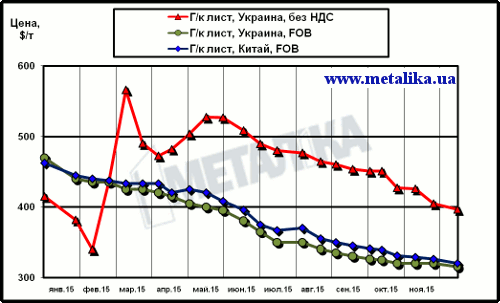Ослабление гривны помогло стабилизировать цены на лист в Украине, однако дальнейшее падение мировых расценок на сталь способно возродить отрицательный тренд и на отечественном рынке плоского проката.
Начиная со второй половины осени, расценки на лист в Украине стабилизировались, несмотря на сезонное уменьшение спроса, с одной стороны, и сохранение отрицательного тренда на внешних рынках — с другой. Пока оба эти фактора перекрываются ослаблением гривны. Долларовый эквивалент внутренних цен за последние два месяца просел намного сильнее, чем экспортные котировки. Внешние расценки идут вниз под влиянием общемирового снижения цен и, похоже, не собираются останавливаться. Пока разрыв между внутренними и внешними ценами сократился до 70–80 $/т, что значительно уменьшило предпосылки для снижения цен в гривне. Впрочем, такие условия могут вновь возникнуть, если национальная валюта стабилизируется на нынешних уровнях, а спад цен на мировых торговых площадках продолжится. На сегодняшний день гривна уже достигла уровней, заложенных в бюджет на следующий год, к тому же предновогодние дни обычно характеризуются укреплением национальной валюты.

Рис. 1. Цены на листовой металлопрокат в Украине (с учетом НДС для партии металла массой 5 т)

Рис. 2. Сравнительная динамика расценок на г/к лист в Китае и в Украине
На мировых рынках металла явно господствует отрицательный тренд. За последние недели котировки руды, ослабленные падением спроса со стороны КНР и избытком предложения от австралийских горняков, прошли путь от 60 до 40 $/т, подешевев на треть, что открывает дорогу для дальнейшего снижения цен на сталь. Значит, и экспортные котировки украинских металлургов могут в ближайший месяц просесть еще на 20–30 $/т. Если при этом долларовый эквивалент внутренних цен на лист останется неизменным, то разрыв между ним и падающими внешними расценками вновь вырастет до 100–110 $/т, что может в конце концов подтолкнуть расценки на лист в Украине к новым минимумам. Правда, необходимо отметить, что снижение мировых цен на сталь само по себе работает на девальвацию гривны, зависящую от притока средств со стороны металлургического сектора. Так что возможно и новое небольшое ослабление национальной валюты, которое способно частично компенсировать негативный эффект от падения котировок на внешних рынках.
Таким образом, в обозримом будущем снижение цен на мировых торговых площадках способно обвалить цены на лист в Украине, если национальная валюта стабилизируется. В случае дальнейшего ослабления гривны отрицательный тренд на украинском рынке плоского проката обещает быть весьма умеренным, а то и вовсе не возникнуть. Во всяком случае на сегодняшний день нет никаких предпосылок для роста ценовых уровней листовой продукции.
Максим Рассоха
15.12.2015



















